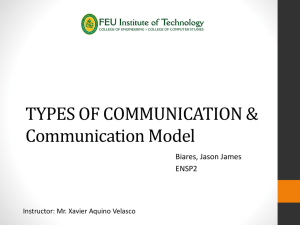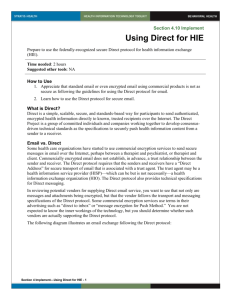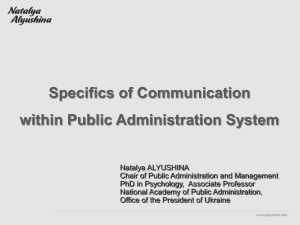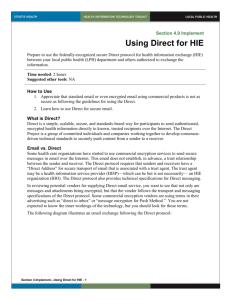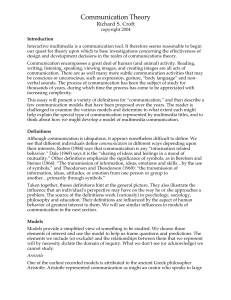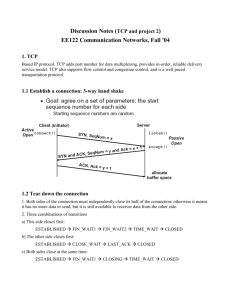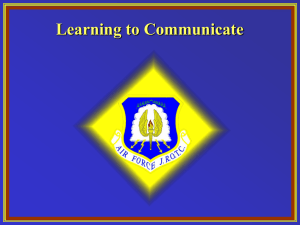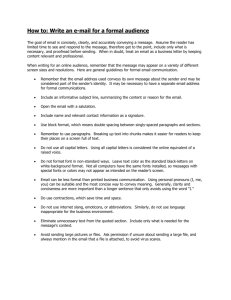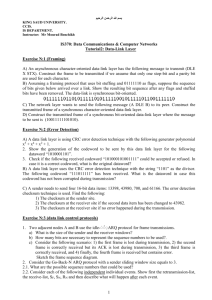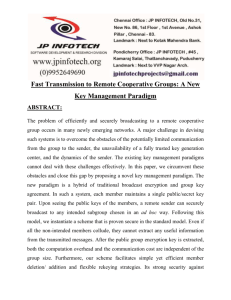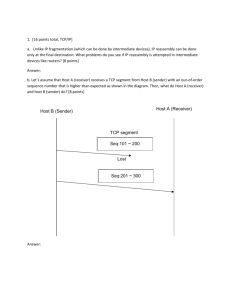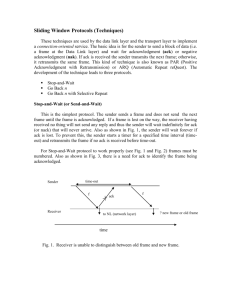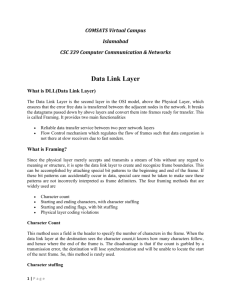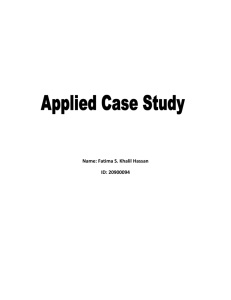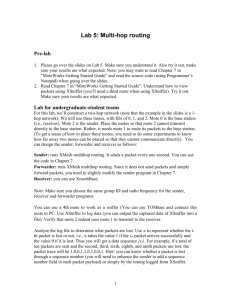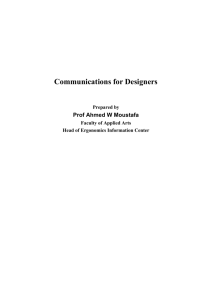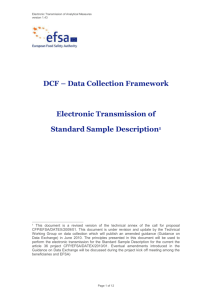COMMUNICATION MODELS - WORKBOOK
advertisement
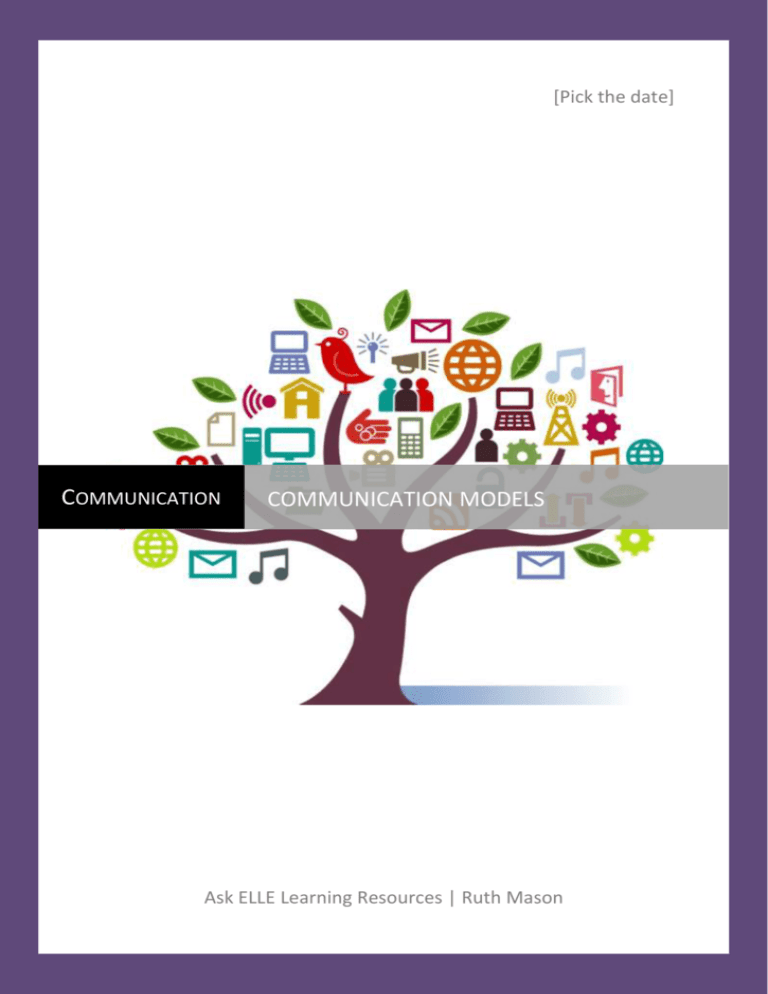
[Pick the date] COMMUNICATION COMMUNICATION MODELS Ask ELLE Learning Resources | Ruth Mason Document1 SMD/Jan 11 Welcome This workbook has been designed to cover the subject area of communication. It is part of a series of workbooks on the subject and this one is designed to cover communication models. The workbook is easy to use and totally flexible. Used in conjunction with your organisations training, the workbook can give you the knowledge and confidence to support you within your job role. Introduction to communication Good, clear communications are vital in everything we do. Mistakes, arguments, unhappiness and even disasters can be caused when information and instructions are not passed on clearly and correctly. At work, you need to remember that some communications are more important than others. In today’s fast paced ever changing world the art of effective communication is a vital and understanding how we communicate is a vital skill in improving business relationships. Every organisation, no matter what their expertise and where they are situated, and what scale they operate, realise and value the importance of good communication. This communication for organisations takes place both within the organisation as well as with other outside stakeholders. Therefore, it is vital for any business to understand the communication models out there, so they can use them for enhancing effective communication. Page 2 of 9 Contents Welcome .................................................................................................................................... 2 Introduction to communication................................................................................................. 2 Introduction ........................................................................................................................... 4 Definition of communication ................................................................................................. 4 Basics of communication ....................................................................................................... 4 Communication Models ......................................................................................................... 5 Summary ................................................................................................................................ 8 Revision Questions..................................................................................................................... 9 Further Learning ........................................................................................................................ 9 Page 3 of 9 Introduction For decades, man has known the importance of communication. Today, with various means by which one can communicate, it has become much easier to communicate a message to the other party, than it was several decades ago. Every organisation, no matter what their expertise and where they are situated, and what scale they operate, realise and value the importance of good communication. This communication for organisations takes place both within the organisation as well as with other outside stakeholders. Therefore, it is vital for any business to understand the communication models out there, so they can use them for enhancing effective communication. Definition of communication Communication is the activity of conveying information through the exchange of thoughts, messages, or information, as by speech, visuals, signals, writing, or behaviour. It is the meaningful exchange of information between two or more living creatures. Basics of communication When looking at the different communication models you need to understand the basics that these models are built on. Communication starts when a person wants to convey information to another person, the person who wants to communicate is called the sender or source. The sender will see this information as a mental image; mental images can include ideas, thoughts, pictures, and emotions. To transfer an image to another person, the sender first must change the images into symbols that can be understood. Symbols often are words but can be pictures, sounds, or sense information (e.g., touch or smell). Only through symbols can the mental images of a sender have meaning for others. The process of translating images into symbols is called encoding. Once a message has been encoded, the next level in the communication process is to transmit or communicate the message to a receiver. This can be done in many ways: during face-to-face verbal interaction, over the telephone, through printed materials (letters, newspapers, etc.), or through visual media (television, photographs). Verbal, written, and visual media are three examples of possible communication channels used to transmit messages between senders and receivers. Other transmission channels can also include touch and gestures. Page 4 of 9 When a message is received by another person, a decoding process occurs. Just as a sender must encode messages in preparation for transmission through communication channels, receivers must sense and interpret the symbols and then decode the information back into images, emotions, and thoughts that make sense to them. When messages are decoded exactly as the sender has intended, the images of the sender and the images of the receiver match, and effective communication occurs. The basic flow of communication can be seen in the diagram below. In this flow, the sender sends a message to the receiver and then they share the feedback on the communication process. You will need to think carefully about the method of communication that you use written, verbal or non verbal, not all communication methods work for all transactions. What is your favourite method of communication? Once the method of communication has been understood you would need to consider the various communication models that can be used. As communication is an important part of business, different types of models have been introduced over a number of years. Communication Models The models help the business understand how communication works, how messages are transmitted, how it is received by the other party, and how the message is eventually interpreted and understood. We are going to have a look at some of the most famous and frequently used communication models. Page 5 of 9 Shannon's Model: One of the earliest models of communication introduced was Claude Shannon's model. This was introduced in 1948. It laid the foundation for different communication models that we have today. The diagram below illustrates how communication takes place and also indicates what could go wrong: In Shannon's model, the information source typically refers to a person, who then sends a message with the use of a transmitter. This transmitter could be any instrument today, from phones to computers and other devices. The signals that are sent and received can be vary depending on the method of communication. The box at the bottom called NOISE refers to any signals that may interfere with the message being carried. This again would depend on the method of communication. Consider that in any face-to-face situation, there may be environmental or other sources of noise that interfere with the communication. Berlo's Model: Berlo (1960) took a different approach to constructing a model. Rather than attempting to identify elements of interest, and relationships between those elements, he created what he called “a model of the ingredients of communication”. This model identifies controlling factors for four identified elements of communication: Source, Message, Channel, and Receiver. This model promises to be helpful in identifying specific factors to use in experimentation. According to this model, for the message to be properly encoded and decoded, the communication skills of both the source and the receiver should be at best. The communication will be at its best only if the two points are skilled. As described above Berlo's model has four main components and each component has its own sub components describing the assisting factors for each. Page 6 of 9 Schramm's Model: Schramm on the other hand, emphasised in 1954 that both the sender and the receiver take turns playing the role of the encoder and the decoder when it comes to communication. The sender encodes the message, based upon the sender’s field of experience. The user’s field of experience guides decoding. If there is no commonality in the sender’s and receiver’s field of experience, then communication does not take place. The extent to which the signal is correctly decoded (that is, decoded so that it is the same as the original message prior to decoding) depends on the extent of the overlap of the two fields of experience. For instance, a lecture on neurophysiology delivered to an audience of children may result in little or no communication. The lecturer has background knowledge of chemistry and biology, and beyond that specialised knowledge of biochemical processes in the nervous system. The audience would lack the vocabulary, if nothing else, to make sense of the information. There are many ideas in this model that should apply for examination of communication under a wide variety of circumstances. Page 7 of 9 Summary These models have been followed by various other models such as the 'Helical' model, Aristotle's models and several other models. You should always keep in mind that each of these models has both their advantages and disadvantages. While some communication models try to break down the whole process in order to make it easier to understand, they are not always as simple as they seem. You need to keep in mind that these complexities that accompany the communication models may only make understanding the communication much harder! It is best that both parties, the source (sender) and the receiver, are clear about what they would like to discuss. This is also known as the context of the message. This would make it much easier to decode what the other party is saying without too much trouble. The process of communication, if kept simple and to the point should not usually have too many issues, and the message will be easily understood by both parties. This workbook is an introduction to how we can utilise and implement different ways of communicating by considering some of the models that have been discussed. It is important that we consider our audience and adapt our communications to meet our personal and business needs. We will all have access to many different types of and methods of communication in our personal and business lives, the way we choose to use these methods and communicate as individuals will always be a personal decision. Therefore, it is recommended that we constantly strive to develop our communication skills taking advantage of new and existing technologies. Page 8 of 9 Revision Questions These questions have been included to help you and your Area Trainer assess your understanding of this module. What is a mental image in the context of communication? From the different models what can stop good communication? When have you experienced communication problems and how would you apply the learning gained from this workbook to make sue it did not happen again Further Learning Identify and investigate other communication models, for example Aristotle. Visit the Ask ELLE website for further communication learning . Page 9 of 9

